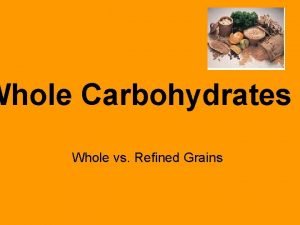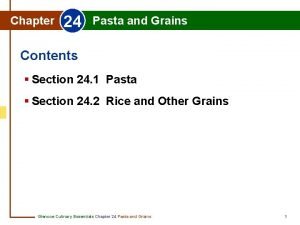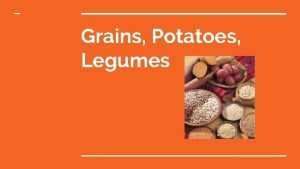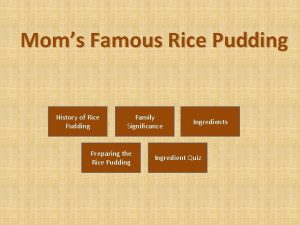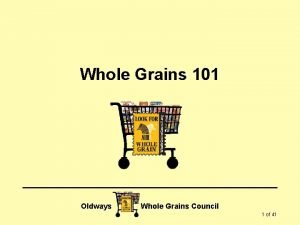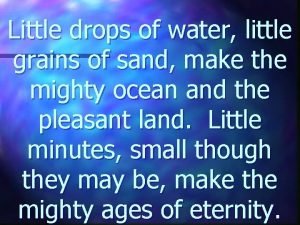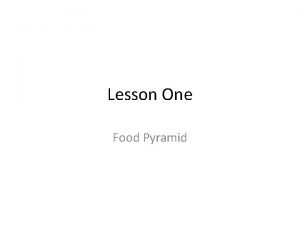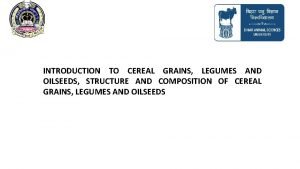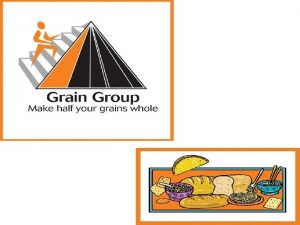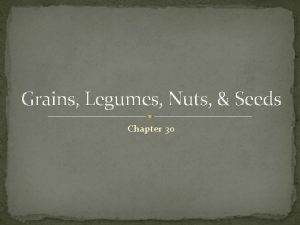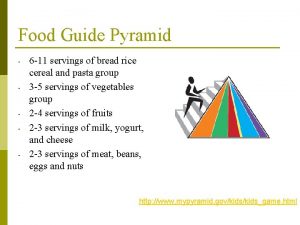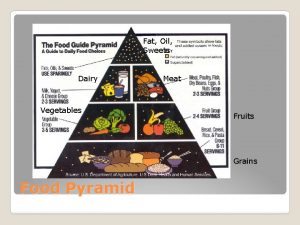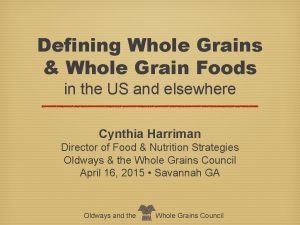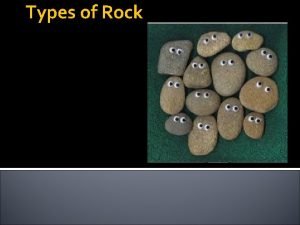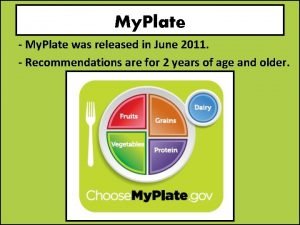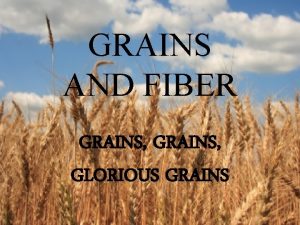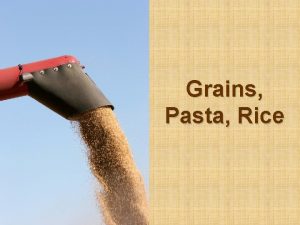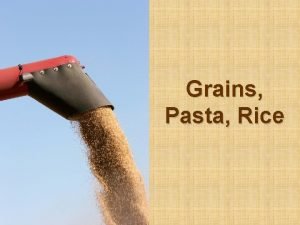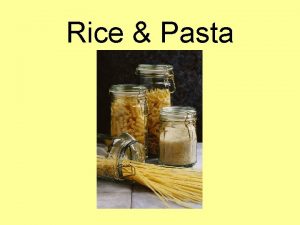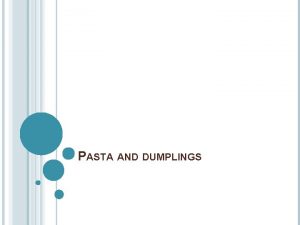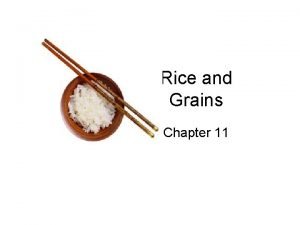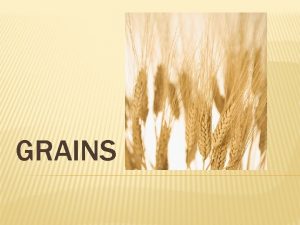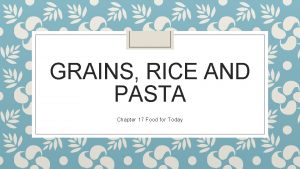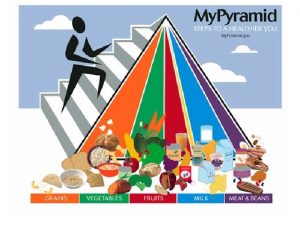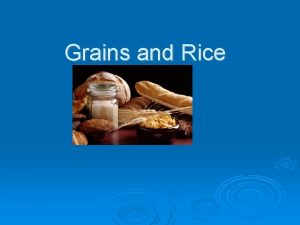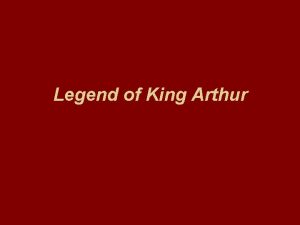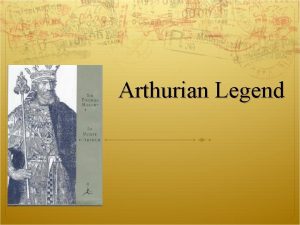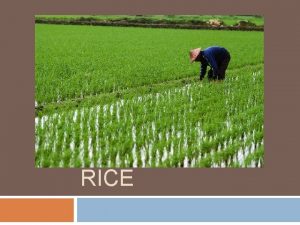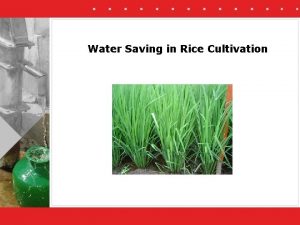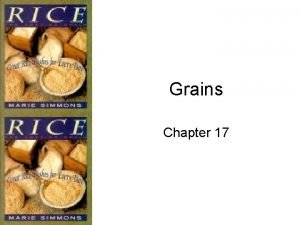Pasta Grains Rice History of Pasta Popular legend




















- Slides: 20

Pasta Grains Rice

History of Pasta Popular legend has it that Marco Polo introduced pasta to Italy following his exploration of the Far East in the late 13 th century The Chinese were making a noodle-like food as early as 3000 B. C. And Greek mythology suggests that the Greek God Vulcan invented a device that made strings of dough (the first spaghetti!). Pasta made its way to the New World through the English, who discovered it while touring Italy. Colonists brought to America the English practice of cooking noodles at least one half hour, then smothering them with cream sauce and cheese. Thomas Jefferson is credited with bringing the first “macaroni” machine to America in 1789 when he returned home after serving as ambassador to France. The first industrial pasta factory in America was built in Brooklyn in 1848 by, of all people, a Frenchman, who spread his spaghetti strands on the roof to dry in the sunshine

Pasta Facts The average American consumes ______lbs. of pasta annually. This makes it the 6 th highest food per capita in the country. As of March 2012, the average price an American pays for pasta is $1. 45 per pound! This makes it one of the most ____________meals. 24% of the global consumption of pasta is by Americans – the largest of any country in the world. Americans consume _______ billion pounds of pasta each year. The United States produces 4. 4 billion pounds of pasta annually, making it the second largest pasta-producing nation.

Convenience You can enjoy pasta on any ______, and thanks to its incredible versatility, you can have a different and delicious low-cost meal every day of the week. Keeping pantry staples like dry pasta on hand is always helpful, especially for those days when the cupboard is a bit bare. No need for pricey takeout!

Nutrition ___________carbohydrates like pasta provides the optimum type of “fuel” to power your muscles and brain, as it is digested more __________, it provides a slower release of energy to keep you going throughout the day. Pasta is an ideal partner for other nutritious foods that are essential to a healthy diet. It’s great to pair with fiber-filled vegetables and beans, heart healthy fish and oils, antioxidant-rich tomato sauce and protein-packed, poultry and lean meats.

Storing Pasta Store ____________, dry pasta in your cupboard for up to one year. Keep in a cool, dry place. Follow the "first-in, first-out" rule: Use up packages you've had the longest before opening new packages. Cooked Pasta Refrigerate cooked pasta in an __________ container for 3 to 5 days. You may add a little oil (1 -2 tsp. for each pound of cooked pasta) to help keep it from sticking. Because cooked pasta will continue to absorb flavors and oils from sauces, store cooked pasta separately from ________. Freezing Pasta The best pasta shapes for freezing are those that are used in ____________ recipes, such as: lasagna, jumbo shells, ziti and manicotti. You'll have better results if you prepare the recipe and freeze it before baking. To bake, thaw the dish and bake as the recipe directs.

For GOOD Pasta MEASURE • Pasta is usually made from __________wheat because of its high protein and gluten. • Pasta __________as it cooks. 1 cup uncooked pasta will yield 2 cups cooked. • Pasta test for doneness to the tooth) ____________( meaning firm

Basic Pasta Ingredients – made from durham wheat, calorie dense– 600 calories per cup, 7 grams of fiber, 21 grams of protein – HIGH GLUTEN!!! _____ We will use _______________Flour

Grains • Definition: single, hard ______ • Grains are the edible seeds of certain grasses. • Most common grains – – –

Kernel of Wheat


Parts of the Grain • _______ - outside covering of the grain and consists of several layers. • _________ - is the inner white portion. – complex carbohydrates , proteins, NO vitamins and minerals • ______ - found at one end of the kernel, is the sprouting part from which a new part grows. – (B vitamins, vitamin E, iron, zinc, other minerals, unsaturated fat)

Wheat Continued… • ________Wheat: used for flour • _________Wheat: type of wheat with high protein and gluten contents • Wheat is known as the staff of life because of its availability around the world. It is a staple food because of its good keeping quality, high energy value and their relatively low cost.

What’s a Whole Grain? • _________Grains : Made from entire kernel including bran, germ, endosperm. • __________grains Milled so germ and bran are removed. : • ___________: Adding nutrients lost during the processing of the grain back into the finished product ex. White flour.

Why do Whole Grains Matter? • Diets rich in whole grain foods and other plant foods, and low in __________ fat and cholesterol, may help reduce the risk of ___________disease • Consuming at least 3 or more ounces-equivalents of whole grains per day can reduce the risk of several _________ diseases and may help with _________maintenance

Processing Grains • Berries: whole grain minus the hull • ______: ground into fine powder • _______= Flaked: flattened between rollers • ________: cut into small pieces to speed up cooking time • Pearled: bran removed and tumbled

RICE

Rice Worldwide there are more than _________ different varieties of rice!

Basic Categories of Rice • _______ grain Rice- Long, polished kernels. Bland somewhat firm in texture. Yields a drier, fluffy rice. – Ex. Basmati and Jasmine • _______ Grain Rice- has a shorter, wider kernel (two to three times longer than its width) than long grain rice. Cooked grains are moist and tender, and have a greater tendency to cling together than long grain. – Ex. Sushi Rice • _______ Grain Rice- Short grain rice has a short, plump, almost round kernel. Cooked grains are soft and cling together. – Ex. Arborio Rice

Cooking Rice • Double the amount of ________for rice (1: 2 ratio) 1. 2. 3. 4. 5. 6. Bring water to boil. Add and stir in rice. Turn heat to low and put on lid. Cook for 20 -25 minutes -- 45 -1 hr (brown rice). Rice is done if no water is visible. Fluff with a fork. **Rice ________as it cooks. - 1 cup uncooked rice yields _______ cups of cooked rice.
 Refined grains
Refined grains Chapter 24 pasta and grains answers
Chapter 24 pasta and grains answers Cooking pasta and rice activity 2 chapter 30
Cooking pasta and rice activity 2 chapter 30 Champa rice ap world history definition
Champa rice ap world history definition Champa rice ap world history
Champa rice ap world history History of rice pudding
History of rice pudding Whole grains council
Whole grains council Grains webquest
Grains webquest Angular grains
Angular grains A student determined that exactly 10 pollen grains
A student determined that exactly 10 pollen grains Little drops of water make a mighty ocean paragraph
Little drops of water make a mighty ocean paragraph Food pyramid questions
Food pyramid questions Structure of cereal grain
Structure of cereal grain 1 serving of grains
1 serving of grains What are grains
What are grains 6-11 servings of grains
6-11 servings of grains Dairy meat fruits vegetables and grains
Dairy meat fruits vegetables and grains Grains examples list
Grains examples list Chapter 11 potatoes and grains
Chapter 11 potatoes and grains Non-banded grains
Non-banded grains What is the key consumer message for dairy
What is the key consumer message for dairy
